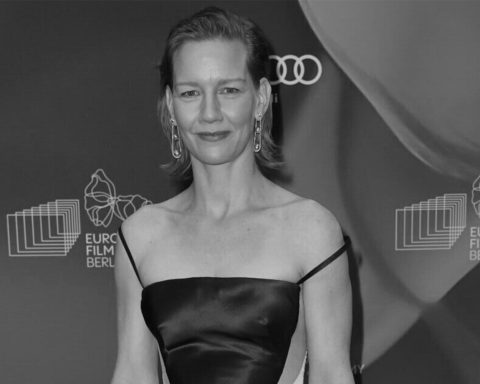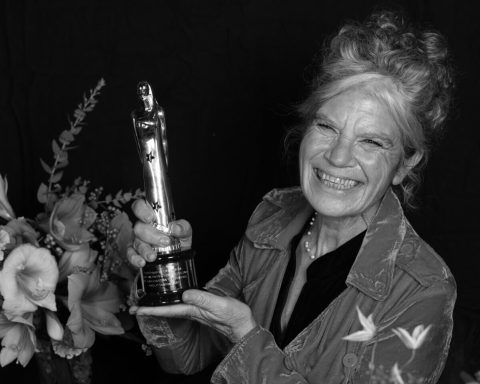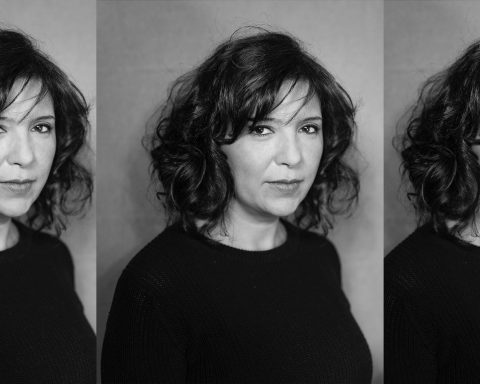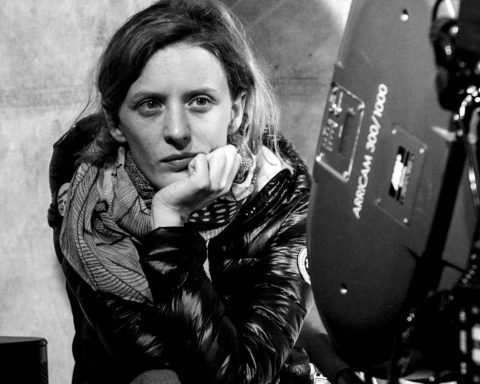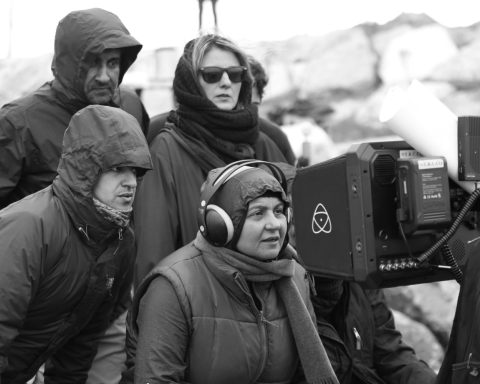Giedrė Žickytė is a Lithuanian film director and producer. She holds an MA in Visual Arts from the Vilnius Art Academy. Her first documentary, “Baras,” (2009) won the Best TV Film Award at the Lithuanian National Film Awards. Her first feature documentary, “How We Played the Revolution,” (2011) was distributed theatrically in Lithuania and screened at many international film festivals, among which the Warsaw Film Festival, International Film Festival Rotterdam, Sheffield DocFest, the Bergen International Film Festival and the Trieste Film Festival. It received the first prize as the Best Baltic States’ Film at the Vilnius International Documentary Film Festival in 2012. Her next documentary feature, “Master and Tatyana,” (2015) won four National Film Awards (Silver Cranes) among which, the Best Directing Award. After that, she directed the acclaimed short documentary, “I’m Not from Here,” (2016) that was also successful on the festival circuit.
Tara Karajica talks to Giedrė Žickytė about her latest film, “The Jump,” an affecting and captivating documentary about the incredible story of Simas Kudirka that had its world premiere at the 2020 Warsaw Film Festival and is now in consideration for the 94th Academy Awards.
How did you get into filmmaking?
Giedrė Žickytė: For a young person, in general, it is very important to meet a person who would have faith in them. At that time, I was studying Journalism. Deep inside, I was silently dreaming about cinema, but I didn’t feel confident enough to choose that path. I was fortunate enough to meet a professor at the Department of Journalism, who was a famous Lithuanian film and photography critic, Skirmantas Valiulis, and a real teacher. He noticed my hidden dream of cinema, and started encouraging me, giving me films to watch and books to read, and really supporting and praising my first documentary trials. Finally, he convinced me to study filmmaking and I am living my dream today thanks to him.
How did The Jump come about?
G.Ž.: It was 2014, when I was in Los Angeles presenting my previous film. After the screening, my friend asked me if I had ever heard about a Lithuanian man who, in the midst of the Cold War, took a leap from the Soviet ship onto an American one for freedom? I was captivated by this image – a tiny human figure between two ships, between two superpowers, two ideologies. I started digging into the story, discovered the further development of events, which were totally breathtaking, and the more research I did, the more I felt that this was my film. Not only because we, as filmmakers, always dream about great stories and this particular one, full of unexpected twists, sounded stranger than fiction, but also because I felt it so personal – I was born in the totalitarian Soviet regime and was ten years old when my homeland of Lithuania regained its independence from the Soviet Union. The unity and solidarity of the society that demonstrated for Simas’ freedom in the ‘70s evoked my child memories about the peaceful demonstrations for freedom when we were breaking away from the Soviet Union at the end of the ‘80s. I will never forget that feeling – it was like first love, so full of dreams and hopes. Therefore, I am attracted to stories about people looking for freedom and the drama that unfolds in the various choices they make.
You opt for a three-act narrative structure for The Jump. Can you talk about this particular choice?
G.Ž.: Simas Kudirka’s story is a classical three-act narrative structure. It plays out like a thriller. To tell the truth, during editing, we tried different options, playing back and forth between his story. However, in the end, I realized that the story itself is so brilliant that it doesn’t need any made-up structures that destroy the magic and emotion of the true story.
How did you find Simas Kudirka and the other people involved in the historical event after so many years? Was it hard to convince Kudirka to be involved in a film about him and to get the others on board as well?
G.Ž.: To tell the truth, the first day I met with him, Simas welcomed me very warmly, but he was not interested in talking about his story that much. He was caring for his sick wife and couldn’t leave home because he didn’t want to leave his wife alone. Little did we both know, a few years later, we would go together to the United States, and visit the same ship where the incident happened and have all this huge journey ahead. Like everywhere in documentary, it’s all about time. I got to know him more and more, he started to trust me more and more, and we both realized why we are making this film, and he also saw the passion of our crew, and he became very passionate himself. I am very grateful that Simas agreed to go for this journey, even being almost ninety years old. He is such a charismatic and artistic character. Whenever the film wins an audience award – the film has already received three audience awards –, I call Simas and tell him: “This award is for you because you make the audience fall in love with you!” Regarding Simas and the other characters, I never convince anybody to be in a film. I just talk, get to know them and ask: “Would you be interested in being a part of it?” I don’t believe in convincing in documentary cinema. The agreement to participate in a film should originate naturally, and come from the inner need of the character; only then does it become true and authentic in the film.
Simas Kudirka has become a symbol for freedom-seeking refugees around the world, a topic that is now relevant more than ever. Can you delve deeper into that?
G.Ž.: The story of Simas’ rescue from prison was a miracle – but this miracle wouldn’t have happened were it not for people who strived to help his release. When I look at the faces of people who took part in these unforgettable massive demonstrations for Simas in the archive images from the ‘70s, it moves me to tears. The unity of society’s efforts when thousands took to the streets, contacted the press, wrote letters to the U.S. President, etc., including two women – Daiva and Gražina – who appear in my film and who devotedly worked for so many years, looking for various ways to save Simas from prison, was amazing. It is unbelievable how society was indifferent to the tragedy of a single person, a man they didn’t know anything about, only his name and one photo he had left behind on the American ship. While politicians were “expressing their deep regret” – as they always do –, the activists didn’t give up and took real actions. It may look naïve because it seemed impossible to rescue Simas, however these actions made by society put media fire under their feet and brought the world’s attention to Simas’ story, which is what kept him alive. Perhaps, there was a certain mood in the society already and the symbolic act of Simas let it all go out. Still, it looks so miraculous today. We hear so many refugee tragedies every day, we see kids dying on the shore, or various regime fighters being imprisoned, but nobody goes to the streets. Does it mean that we have already gotten used to these tragic news appearing in the media everyday? Do we forget that nobody leaves their home if they are feeling good and safe there? Sometimes, we may think – including me, of course – that it’s enough to write “I care” on social media and comfortably think that that’s all we can do. We should never forget that every refugee crisis, no matter how complex or political it is, involves real human beings and their real life stories.
Can you talk about the research process? What did you learn while making this film?
G.Ž.: The story is very complex, so it took many years to research, develop, and finally produce the film. I could talk about the research process for hours, but let me share a few lessons. First, never give up. For example, when I learned that the authentic ship where Simas Kudirka jumped on fifty years ago still exists, I got the idea that we should sail and recreate the story in this ship. It took me a year and a half to get all the required permissions to get on board. Many people were telling me to abandon this idea about the ship and find an alternative solution. Once I got the permission and was able to literally step on the deck of the ship together with the protagonist, Simas, and our crew, I felt like kissing the ground from all the happiness. Another example is an interview with Mr. Kissinger. It was already during editing when I found a very special archive where Kissinger was sharing a story about Simas in the most unexpected way. I realized I needed to interview him for the film. Everybody told me it was impossible. But I tried and, to my surprise, Mr. Kissinger agreed to grant me this interview. The second lesson was: always ask twice. During research, I was reading all the U.S. press on Simas I could find. Whenever I noticed a picture with a TV camera filming Simas, I would zoom the image and try to see the name of the TV channel and mark the date of the article. With that information, I would go back to the TV stations and try to find the archives. So, we would make a request to the TV channel, asking to look for the archive of that particular day. But the archivist would tell us they didn’t have anything on that matter. The next day, we would try the same request, but with a different person. He was in a better mood, more interested to help and he found the archive. So, always ask twice!
Would you agree with the assumption that The Jump is the perfect example of historical revisionism and cultural/historical memory? In that sense, what impact do you think the film has had?
G.Ž.: In Lithuania, the story about Simas Kudirka’s defection was not revised, rather it was withheld from the public. Any incident that was interpreted by the USSR as betrayal was hidden from the public in order not to inspire other potential acts of disobedience. This event raises the importance of solidarity and people coming together. The role of the diaspora is extremely important in the freedom movement. For many in the United States, Kudirka’s story brought attention to the occupation of the Baltic States. It resonated with the American public and the principles of freedom that they cherish. The story is relevant today given that the migrant crisis is ongoing globally.
Are you a feminist? If so, how does it inform your filmmaking?
G.Ž.: I really appreciate what has already been accomplished within the movement. It’s difficult to imagine that less then a hundred years ago women were not able to vote, to visit cafés, to wear trousers, to have their own income and, most importantly, to make their own decisions. For me, feminism is about being who you are – being the woman that you are, the way you want to be. It’s about doing what you want to do in life, about having the freedom to choose, to create, to achieve goals and being paid and respected equally. It’s basic human rights. There are still obstacles for women to do that. People are still surprised when I say I’m a film director. If I say that I work in the film industry, their first idea is that I am an actress. It looks like film directing sometimes still pertains to men’s territory.
Do you have a favorite female filmmaker and a favorite film by a female filmmaker?
G.Ž.: Agnès Varda and her oeuvre.
What are you working on next?
G.Ž.: I am working on a new documentary – yet another passionate and dramatic story, but this time, the main protagonist is a woman.
Photo credits: Courtesy of Giedrė Žickytė.



